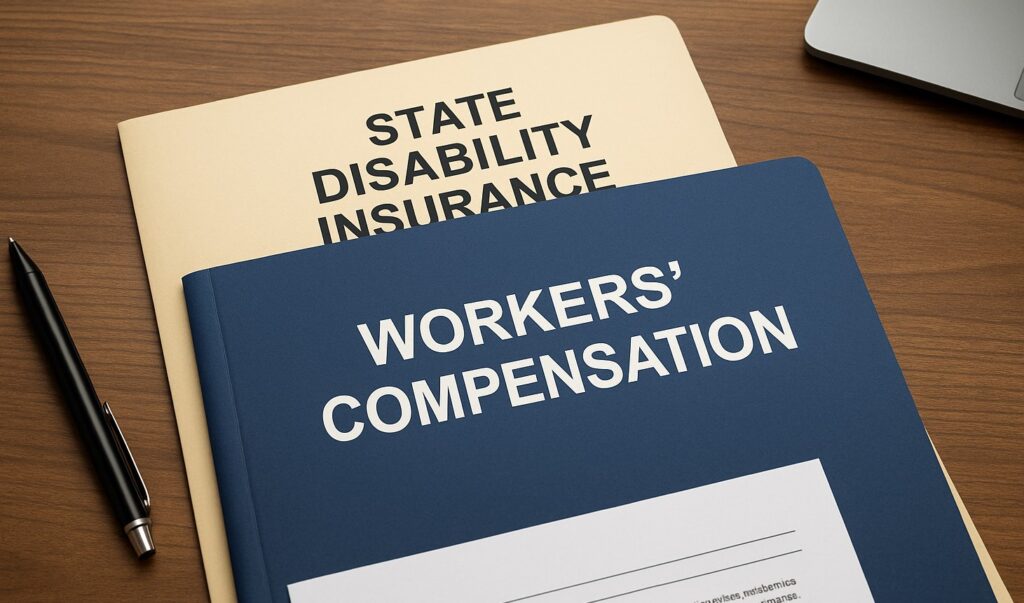
If you’ve been injured at work in California, you may be wondering:
Can I collect State Disability Insurance (SDI) and workers’ comp at the same time?
The answer: Sometimes — but not for the same injury, and not for the same time period.
Understanding when and how SDI and workers’ comp benefits interact is key to maximizing your income during recovery.
At Employees First Labor Law, we help injured workers navigate overlapping benefit systems — and ensure they don’t leave money on the table.
🔹 What’s the Difference Between Workers’ Comp and SDI?
- Workers’ Compensation: Covers job-related injuries or illnesses. Pays for medical care, disability benefits, and future medical needs. Paid by your employer’s insurance.
- State Disability Insurance (SDI): Covers non-work-related injuries or illnesses. Provides partial wage replacement. Paid through deductions from your paycheck, administered by the EDD.
🔹 Can You Get Both at the Same Time?
❌ Not for the Same Period and Same Injury
You can’t collect full workers’ comp disability payments and SDI at the same time for the same injury. That would be considered double-dipping, and you’d likely be required to repay the EDD.
However, you may be eligible for SDI when:
- Your workers’ comp claim is delayed or denied
- You haven’t started receiving TTD yet
- You have a second injury or medical condition that isn’t work-related
🔹 When SDI Can Help You While on Workers’ Comp
Here are a few real-world examples:
✅ Your claim is under investigation
You were injured at work, but the insurance company hasn’t approved your claim yet. You can apply for SDI while you wait — and it won’t impact your final workers’ comp eligibility.
✅ You’re ineligible for workers’ comp for part of your condition
You have a pre-existing medical issue aggravated by work. Workers’ comp may only cover part of your symptoms, so SDI could help with the rest.
✅ Your employer disputes the claim
In denied claims, SDI can offer income while you appeal or litigate.
🔹 Can SDI Be Used to Supplement Workers’ Comp?
Usually, no. You cannot “stack” SDI and workers’ comp TTD to receive more than your regular wages. However, in some cases:
- SDI may fill in gaps when workers’ comp doesn’t pay the full 2/3 wage replacement
- You may be able to switch from workers’ comp to SDI if your injury is no longer considered job-related
You may also apply for Paid Family Leave (PFL) through EDD if you’re caring for a family member — which is separate from SDI.
🔹 What Happens If You Receive SDI and Workers’ Comp Together?
If you’re later found eligible for workers’ comp for a period when you received SDI:
- The EDD may issue a lien on your workers’ comp benefits
- Your attorney will coordinate reimbursement
- You typically won’t owe anything out of pocket — the insurers work it out
🔹 EFLL Helps You Maximize Every Benefit
Workers’ comp claims can stall, and benefit systems often don’t talk to each other. That’s where we come in.
At Employees First Labor Law, we:
- File for SDI while your workers’ comp claim is pending
- Challenge unjust claim denials
- Protect your eligibility and prevent overpayment issues
- File retaliation or wrongful termination claims if your employer punishes you for taking time off to heal
You shouldn’t go broke waiting for your benefits. We make sure every possible option is explored.
✅ Get Help Today
If you’re unsure whether to file for SDI or need help navigating a delayed or denied workers’ comp case, contact Employees First Labor Law for a free consultation.



